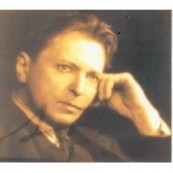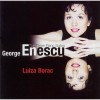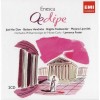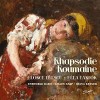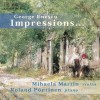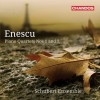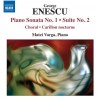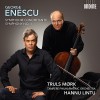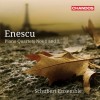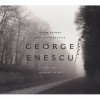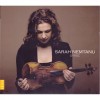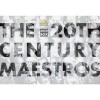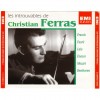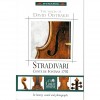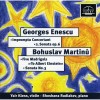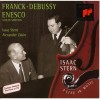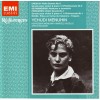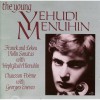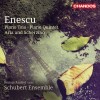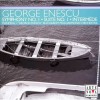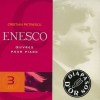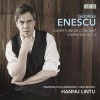Composers
George Enescu (Romanian pronunciation: [ˈd͡ʒe̯ord͡ʒe eˈnesku]; known in France as Georges Enesco; 19 August 1881, Liveni – 4 May 1955, Paris) was a Romanian composer, violinist, pianist, conductor and teacher.
Enescu was born in the village of Liveni (later renamed "George Enescu" in his honor), Dorohoi County at the time, today Botoşani County. He showed musical talent from early in his childhood. A child prodigy, Enescu created his first musical composition at the age of five.[1] Shortly thereafter, his father presented him to the professor and composer Eduard Caudella. At the age of seven, he entered the Vienna Conservatory, where he studied with Joseph Hellmesberger, Jr., Robert Fuchs, and Sigismund Bachrich. He graduated before his 13th birthday, earning the silver medal. In his Viennese concerts young Enescu played works by Brahms, Sarasate and Mendelssohn. In 1895 he went to Paris to continue his studies. He studied violin with Martin Pierre Marsick, harmony with André Gedalge, and composition with Jules Massenet and Gabriel Fauré.
Many of Enescu's works were influenced by Romanian folk music, his most popular compositions being the two Romanian Rhapsodies (1901–2), the opera Œdipe (1936), and the suites for orchestra.[citation needed] He also wrote five symphonies (two of them unfinished), a symphonic poem Vox maris, and much chamber music (three sonatas for violin and piano, two for cello and piano, a piano trio, two string quartets and two piano quartets, a wind decet (French, "dixtuor"), an octet for strings, a piano quintet, and a chamber symphony for twelve solo instruments). A young Ravi Shankar recalled in the 1960s how Enescu, who had developed a deep interest in Oriental music, rehearsed with Shankar's brother Uday Shankar and his musicians. Around the same time, Enescu took the young Yehudi Menuhin to the Colonial Exhibition in Paris, where he introduced him to the Gamelan Orchestra from Indonesia.
On 8 January 1923 he made his American debut as a conductor in a concert given by the Philadelphia Orchestra at Carnegie Hall in New York City, and he subsequently made frequent returns to the United States. It was in America, in the 1920s, that Enescu was first persuaded to make recordings as a violinist. He also appeared as a conductor with many American orchestras, and in 1936 he was one of the candidates considered to replace Arturo Toscanini as permanent conductor of the New York Philharmonic.[3] In 1935, he conducted the Orchestre Symphonique de Paris and Yehudi Menuhin (who had been his pupil for several years starting in 1927) in Mozart's Violin Concerto No. 3 in G major. He also conducted the New York Philharmonic between 1937 and 1938. In 1939 he married Maria Rosetti (known as the Princess Cantacuzino through her first husband Mihail Cantacuzino), a good friend of the Queen Marie of Romania. While staying in Bucharest, Enescu lived in the Cantacuzino Palace on Calea Victoriei (now the George Enescu Museum, dedicated to his work).
He lived in Paris and in Romania, but after World War II and the Soviet occupation of Romania, he remained in Paris.
He was also a noted violin teacher. Yehudi Menuhin, Christian Ferras, Ivry Gitlis, Arthur Grumiaux, Ida Haendel and Joan Field were among his pupils. He promoted contemporary Romanian music, playing works of Constantin Silvestri, Mihail Jora, Ionel Perlea and Marţian Negrea.
He was a National Patron of Delta Omicron, an international professional music fraternity.[4][not in citation given]
On his death in 1955, George Enescu was interred in the Père Lachaise Cemetery in Paris.
Today, Bucharest houses a museum in his memory; likewise, the Symphony Orchestra of Bucharest and the George Enescu Festival—founded by his friend, musical advocate, and sometime collaborator, the conductor George Georgescu[5]—are named and held in his honor. Recently, Bacau International Airport was named George Enescu International Airport.
Eugène Ysaÿe's Solo Violin Sonata No. 3 "Ballade" was dedicated to Enescu.
Recently Added
| Country: | Romania |
| Period: | Romantique |
Biography
George Enescu (Romanian pronunciation: [ˈd͡ʒe̯ord͡ʒe eˈnesku]; known in France as Georges Enesco; 19 August 1881, Liveni – 4 May 1955, Paris) was a Romanian composer, violinist, pianist, conductor and teacher.
Enescu was born in the village of Liveni (later renamed "George Enescu" in his honor), Dorohoi County at the time, today Botoşani County. He showed musical talent from early in his childhood. A child prodigy, Enescu created his first musical composition at the age of five.[1] Shortly thereafter, his father presented him to the professor and composer Eduard Caudella. At the age of seven, he entered the Vienna Conservatory, where he studied with Joseph Hellmesberger, Jr., Robert Fuchs, and Sigismund Bachrich. He graduated before his 13th birthday, earning the silver medal. In his Viennese concerts young Enescu played works by Brahms, Sarasate and Mendelssohn. In 1895 he went to Paris to continue his studies. He studied violin with Martin Pierre Marsick, harmony with André Gedalge, and composition with Jules Massenet and Gabriel Fauré.
Many of Enescu's works were influenced by Romanian folk music, his most popular compositions being the two Romanian Rhapsodies (1901–2), the opera Œdipe (1936), and the suites for orchestra.[citation needed] He also wrote five symphonies (two of them unfinished), a symphonic poem Vox maris, and much chamber music (three sonatas for violin and piano, two for cello and piano, a piano trio, two string quartets and two piano quartets, a wind decet (French, "dixtuor"), an octet for strings, a piano quintet, and a chamber symphony for twelve solo instruments). A young Ravi Shankar recalled in the 1960s how Enescu, who had developed a deep interest in Oriental music, rehearsed with Shankar's brother Uday Shankar and his musicians. Around the same time, Enescu took the young Yehudi Menuhin to the Colonial Exhibition in Paris, where he introduced him to the Gamelan Orchestra from Indonesia.
On 8 January 1923 he made his American debut as a conductor in a concert given by the Philadelphia Orchestra at Carnegie Hall in New York City, and he subsequently made frequent returns to the United States. It was in America, in the 1920s, that Enescu was first persuaded to make recordings as a violinist. He also appeared as a conductor with many American orchestras, and in 1936 he was one of the candidates considered to replace Arturo Toscanini as permanent conductor of the New York Philharmonic.[3] In 1935, he conducted the Orchestre Symphonique de Paris and Yehudi Menuhin (who had been his pupil for several years starting in 1927) in Mozart's Violin Concerto No. 3 in G major. He also conducted the New York Philharmonic between 1937 and 1938. In 1939 he married Maria Rosetti (known as the Princess Cantacuzino through her first husband Mihail Cantacuzino), a good friend of the Queen Marie of Romania. While staying in Bucharest, Enescu lived in the Cantacuzino Palace on Calea Victoriei (now the George Enescu Museum, dedicated to his work).
He lived in Paris and in Romania, but after World War II and the Soviet occupation of Romania, he remained in Paris.
He was also a noted violin teacher. Yehudi Menuhin, Christian Ferras, Ivry Gitlis, Arthur Grumiaux, Ida Haendel and Joan Field were among his pupils. He promoted contemporary Romanian music, playing works of Constantin Silvestri, Mihail Jora, Ionel Perlea and Marţian Negrea.
He was a National Patron of Delta Omicron, an international professional music fraternity.[4][not in citation given]
On his death in 1955, George Enescu was interred in the Père Lachaise Cemetery in Paris.
Today, Bucharest houses a museum in his memory; likewise, the Symphony Orchestra of Bucharest and the George Enescu Festival—founded by his friend, musical advocate, and sometime collaborator, the conductor George Georgescu[5]—are named and held in his honor. Recently, Bacau International Airport was named George Enescu International Airport.
Eugène Ysaÿe's Solo Violin Sonata No. 3 "Ballade" was dedicated to Enescu.
